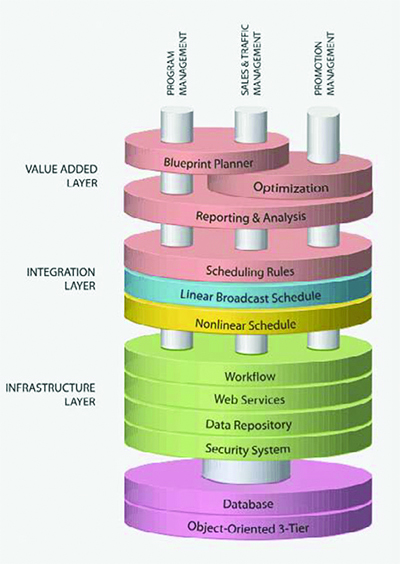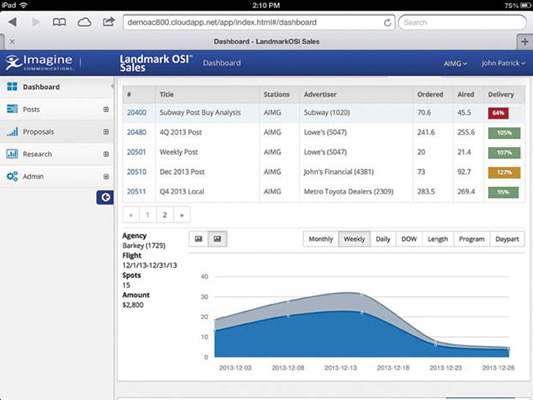Traffic & Billing Branches Out
SAN FRANCISCO—It’s akin to a thousand-piece puzzle that’s never quite complete: adding a spot here, repeating a clip there, deleting another a moment before it’s set to get on air.
And so it goes, minute after minute, when it comes to traffic and billing technologies. It’s a system that should—at its best—serve as a quiet spoke and hub at a center of a station, as it’s one of the rare technologies in the professional video industry that has an impact on both the programming and business ends of the spectrum.
The technology itself has come a long way from the days when a simple pen and paper list and a pair of speedy sneakers were the best means of scheduling an ad and then standing by to make sure it was ready to air at the right time. While the technology has been tested and tweaked over the last three decades in an effort to find the right mix of ease-of-use and adaptability, it’s remains clear that the technology still lives on a seesaw; on one side is preparedness, on the other is skill to pull together everything at the last second.
SintecMedia’s OnAir solution combines major operations—including sales, traffic, programming, promo management and billing—into an integrated system. UP TO THE MINUTE
And despite the wealth of information and tech at our fingertips today, traffic and billing is often still led by guesswork.

“Often, you don’t know [the final details of an ad] until the last minute,” said Adam Roberts, CTO for media business for Imagine Communications in Frisco, Texas, whose LandmarkOSI is designed as a sales, traffic and billing solution that connects with the company’s Media Central IP-based architecture. The combination allows workflows like traffic, sales, playout and automation to be migrated to the cloud.
“That provides an end-to-end solution where you can go from managing contracts that you have, to splitting up inventory, to selling inventory and driving that down into automation and playout,” Roberts said. A live log editor within LandmarkOSI connects a traffic schedule directly to a playlist to eliminate the need for manual communications or handwritten playlist changes.
“That gives users the ability to drive the schedule from the business side and into playout and make changes at the last second,” Roberts added. “This integration brings in frame-accurate timing, ingests frame-accurate times, and updates the traffic system with actual frame-accurate times of the segments and the commercial inventory.”
Get the TV Tech Newsletter
The professional video industry's #1 source for news, trends and product and tech information. Sign up below.
The system also features real-time information to maximize station inventory, the ability to be used as a private cloud, as well as support options such as remote shadow training.
Developing a more robust traffic and billing technology was one of the benefits of WideOrbit’s trio of acquisitions this year, including the purchase of Fiva, a digital advertising software manufacturer; Abacast, a developer of streaming, live and on-demand ad insertion solutions; and Admeta, a provider of digital programmatic sell-side platforms. As a result, the company is poised to introduce new features to its range of media, sales and advertising management solutions like WO Media Sales and WO Traffic, the latter of which is used to manage multiple channels and multiple media for TV, media networks, Internet and digital display.
“We’re investing very heavily in digital with our purchase of three companies in the last three months,” said Eric Mathewson, CEO of WideOrbit.
One broad goal is to help networks create a cohesive solution that manages a notoriously difficult process: managing both linear and nonlinear sales and tracking. “If you look at ad operations now, it’s a manual process,” Mathewson said. “If you look at the traditional linear television side, it’s far more automated. Our clients asked us to wade in to solve the automation process.”
In the last few months, WideOrbit announced adoption of its WO Traffic Internet Orders solution to more than 100 broadcast stations to help with the management of digital and spot advertising. The system works to eliminate order entry redundancies and create consolidated orders, contract and invoice summaries. The San Francisco-based company is also seeing growing interest in WO Media Sales, its advertising sales management and proposal solution.
INTEGRATED SYSTEM
Providing a comprehensive solution was also the goal of SintecMedia, whose OnAir solution combines major operations—including sales, traffic, programming, promo management and billing—into an integrated system. The result, the company said, is better communication across the organization, elimination of duplicate data entries and an improved ability to leverage airtime to increase profits.
“These days we think more of managing the entire operation than thinking just of traffic and billing,” said Geoff Nagel, vice president of market strategy for the Israelibased company. The newest version of OnAir includes a new user interface and tightened workflow between various departments. This all-in-one concept means that “anytime anyone changes the schedule or moves the program aground, that has downstream effects on sales, ad sales and promotions,” he said. “This workflow then detects that change and notifies those downstream departments.”

Imagine Communications’ Landmark OSi “We’re trying to move people from being reactive to proactive,” Nagel continued, adding that the company is also working on improving integration from automation systems with live logs that reduce the operational burden of a late-breaking revision to a log.
Earlier this year SintecMedia acquired Pilat Media, a U.K.- based developer of business management software for media companies, in a stock deal worth approximately $103 million. The acquisition was designed to broaden Sintec- Media’s portfolio of business management solutions, including Pilat’s MediaPro advertising sales system. The company also made news earlier this year when Fox Networks Group selected SintecMedia’s OnAir Enterprise broadcast management solution to address ad sales, traffic, programming, scheduling, promotions, rights management and billing for their North American broadcast networks.
At the IBC Show next month, the company will showcase OnAir 4.0 as well as CloudOnAir, an enterprise-level, cloud-based business management SaaS (software as a service) solution tailored to small and mid-size broadcasters.
EVOLVING TREND
Like many companies, SintecMedia has also been traversing the tricky tightrope between different platforms. Does it make sense to create a single traffic and billing platform for broadcast, mobile and the Web? Or is it logical to keep those disparate departments separated?
SintecMedia has a pilot program underway with a European client who is using OnAir for both traditional linear and nonlinear platforms. “It’s an evolving trend,” said Tom Hultquist, director of sales engineering for SintecMedia. “We’re trying to answer questions, such as: does one salesperson cover both sides? How do they structure their sales force? How do [you account for] the differences between how they’re handled?”
Myers Information Systems is one company that has both pinpointed and expanded its focus when it comes to traffic and billing, focusing on managing the entire process starting with acquisition, said Crist Myers, CEO of the Northampton, Mass.-based company. With a focus on independent media facilities that produce, acquire and manage their own content, Myers has outfitted its technology to address sales, traffic and media responsibility from acquisition and storage.
Myers recently released a new version of its ProWeb solution, designed to better display real-time broadcast schedules and program information that’s generated within the ProTrack scheduling environment. The newest version is designed to keep viewers engaged in upcoming programming line-ups. Features include a responsive Web architecture that allows schedules to be displayed on smartphones, tablets and PCs. An embedded Google Analytics feature allows stations to track and measure viewer engagement.
Earlier this month, the company announced that
The Digital Convergence Alliance, a not-for-profit corporation consisting of 13 PBS stations—including six in Florida—installed Myers ProTrack Hub & Spoke solution for the alliance’s new Jacksonville Fla.-based network operations center that is providing master control services for its member stations.
What is clear is that the industry’s traffic and billing technologies are evolving to manage more complex media workflows. The days of the sneakernet are in the past.
“[Within ProTrack you can] automate messages to move content to where it needs to be,” Myers said. “By doing that, you eliminate a lot of downstream noise. Previously, you’d schedule content, print it out and walk it down. Now we tell the arms and legs what to do, and we do that all through integration.”
The solution, he said, is to install a traffic and billing system that’s connected to the centralized system: “There’s more money to save in operations than to gain in sales,” he said.
Connections is the key for ScheduALL as well, as the company recently introduced the newest version of the ScheduALL Connector, a booking platform that unites ScheduALL systems across enterprises and supply chains allowing customers to access their providers’ resource inventory. The goal is to minimize error-prone manual processes and conflicts through a centralized view of all resources.
Susan Ashworth is the former editor of TV Technology. In addition to her work covering the broadcast television industry, she has served as editor of two housing finance magazines and written about topics as varied as education, radio, chess, music and sports. Outside of her life as a writer, she recently served as president of a local nonprofit organization supporting girls in baseball.

